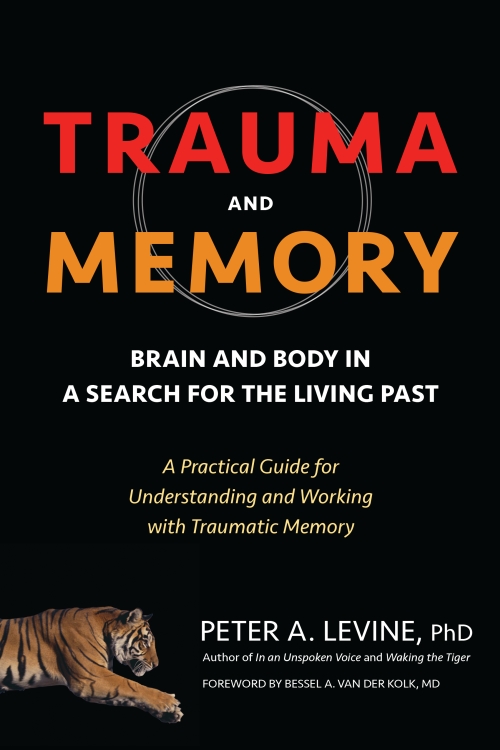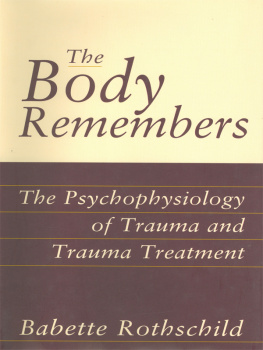
PRAISE for TRAUMA AND MEMORY
In yet another seminal work Peter Levine here deconstructs traumatic memory, making it accessible to healing and transformation. He helps ustherapist or clientmove from a limiting past to where we belong: the empowered present.
Gabor Mat, MD, author of In the Realm of Hungry Ghosts: Close Encounters with Addiction and When the Body Says No: Exploring the Stress-Disease Connection
Arguably, much of our lives are spent at the mercy of the automatic brain; this is only accentuated for those who have experienced severe trauma. In writing with such depth and insight about the psychobiological dynamics of procedural memory, master therapist Peter Levine offers therapists important tools for the transformation of traumatic memory. Moreover, the writing and rich examples make this book accessible so that professionals and nonprofessionals alike can benefit from its wisdom.
Stan Tatkin, PsyD, MFT, author of Wired for Love; founder of the PACT Institute
With this book, Dr. Levine has made another significant contribution to the treatment of trauma. Drawing on established neuroscience he explains, in clear and accessible terms, the various kinds of memory, their neurological bases, and their role in the treatment of trauma. This book is invaluable for clinicians wishing to improve their skills, laypeople wanting a deeper understanding of the way the mind and brain work to create and heal trauma, and scientists looking to understand the implications of modern neuroscience for the treatment of trauma by the body-oriented psychotherapies.
Peter Payne and Mardi Crane-Godreau, PhD, researchers at the Geisel School of Medicine at Dartmouth College
TRAUMA AND MEMORY
BRAIN AND BODY IN A SEARCH FOR THE LIVING PAST
A Practical Guide for Understanding and Working with Traumatic Memory
PETER A. LEVINE, PhD
Foreword by Bessel A. Van der Kolk, MD

North Atlantic Books
Berkeley, California
Copyright 2015 by Peter A. Levine. All rights reserved. No portion of this book, except for brief review, may be reproduced, stored in a retrieval system, or transmitted in any form or by any meanselectronic, mechanical, photocopying, recording, or otherwisewithout the written permission of the publisher. For information contact North Atlantic Books.
Published by
North Atlantic Books
Berkeley, California
and
ERGOS Institute Press
P.O. Box 110
Lyons, Colorado 80540
Cover photo Shutterstock.com/Volt Collection
Cover by Howie Severson
Photos on Laura Regalbuto. All other photos and illustrations Justin Snavely, except where noted.
Trauma and Memory: Brain and Body in a Search for the Living Past is sponsored and published by the Society for the Study of Native Arts and Sciences (dba North Atlantic Books), an educational nonprofit based in Berkeley, California, that collaborates with partners to develop cross-cultural perspectives, nurture holistic views of art, science, the humanities, and healing, and seed personal and global transformation by publishing work on the relationship of body, spirit, and nature.
North Atlantic Books publications are available through most bookstores. For further information, visit our website at www.northatlanticbooks.com or call 800-733-3000.
Library of Congress Cataloging-in-Publication Data
Levine, Peter A., author.
Trauma and memory : brain and body in a search for the living past : a practical guide for understanding and working with traumatic memory / Peter A. Levine.
pages cm
Summary: Discusses different types of memory formation, especially traumatic memory, and how somatic or body-based memory can be utilized in the therapeutic process Provided by publisher.
ISBN 978-1-58394-994-8 (paperback) ISBN 978-1-58394-995-5 (ebook)
1. Memory disorders. 2. Episodic memory. 3. Psychic trauma. 4. Post-traumatic stress disorder. I. Title.
BF376.L48 2015
153.13dc23
2015023111
Memory is the scribe of the soul.
A RISTOTLE
In wrestling with the complex topic of traumatic memory, and making it comprehensible and practical, I offer my deep and special appreciation to Laura Regalbuto, my primary editor. Her contribution, however, goes well beyond that role, as she has many times challenged and nudged me in the direction of greater clarity, cohesion, and simplicity. Laura, you have been a partner and fellow traveler on this long road of discovery, understanding, and communication. To Justin Snavely, often working behind the scenes, I thank you for your fabulous technical assistance and help with the illustrations.
I wish to acknowledge my partners at North Atlantic Books, particularly Erin Wiegand, the project manager. And although we sometimes didnt agree on every editorial point, it was always a collaborative effort, infused with mutual good will and respect. Also, my appreciation to Lauren Harrison for her copyediting and the artistic staff at NAB, for their help on the cover design and layout.
Finally, to Richard Grossinger, the founder of North Atlantic Books: You have held to a lifelong vision of promoting high-caliber books on healing. I hope that you and NAB will continue in this independent and pioneering direction. Many of the books that were once considered fringe are now part of a revitalized mainstream, thanks in large part to your vision and commitment.
Contents
The study of traumatic memories has a long and venerable pedigree in psychology and psychiatry. It goes back at least to Paris in the 1870s, when Jean-Martin Charcot, the father of neurology, became fascinated with the question of what caused the paralyses, jerky movements, swooning, sudden collapse, frenzied laughter, and dramatic weeping in the hysterical patients on the wards of the hospital of the Salptrire. Charcot and his students gradually came to understand that these bizarre movements and body postures were the physical imprints of trauma.
In 1889, Charcots student Pierre Janet wrote the first book on what we now would call PTSD, Lautomatisme psychologique, in which he argued that trauma is held in procedural memoryin automatic actions and reactions, sensations and attitudes, and that trauma is replayed and reenacted as visceral sensations (anxiety and panic), body movements, or visual images (nightmares and flashbacks). Janet put the issue of memory front and center in dealing with trauma: An event only becomes a trauma when overwhelming emotions interfere with proper memory processing. Afterward, traumatized patients react to reminders of the trauma with emergency responses appropriate to the original threat, but these reactions now are completely out of placelike ducking in panic under the table when a drinking glass falls on the floor, or going into a rage when a child starts crying.
For well over a century we have understood that the imprints of trauma are stored not as narratives about bad things that happened
Janet also noted that traumatized people get stuck in the past: They become obsessed with the horror they consciously want to leave behind, but they keep behaving and feeling as if it is still going on. Unable to put the trauma behind them, their energy is absorbed by keeping their emotions under control at the expense of paying attention to the demands of the present. Janet and his colleagues learned from bitter experience that the traumatized women under their care could not be cured by reasoning or insight, behavior modification or punishment, but that they did respond to hypnotic suggestion: Trauma could be resolved by reliving the events in a hypnotic trance state. By safely replaying the old events in their minds and then constructing an imaginary satisfactory conclusionsomething they had been unable to do during the original event because they had been too overwhelmed by helplessness and horrorthey could begin to fully realize that they had, in fact, survived the trauma and could resume their lives.










